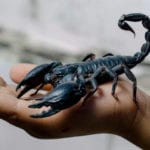 Mysteries
Mysteries  Mysteries
Mysteries  History
History 10 Surprising Stories About the Texas Rangers
 Humans
Humans 10 Philosophers Who Were Driven Mad by Their Own Theories
 Miscellaneous
Miscellaneous 10 Video-Game-Worthy Weapons and Armors from History
 Weird Stuff
Weird Stuff 10 Psychics Who Accurately Predicted Wartime Events
 The Arts
The Arts 10 Pieces of Art Inspired by a Broken Heart
 Health
Health 10 Science Fiction-Sounding New Medical Treatments
 History
History 10 Surprising Facts About the Father of Submarine Warfare
 Space
Space Ten Astonishing New Insights into Alien Worlds
 Weird Stuff
Weird Stuff 10 Bizarre Summer Solstice Rituals Still Practiced Today
 Mysteries
Mysteries Top 10 Haunting Facts About the Ghost Ship MV Alta
 History
History 10 Surprising Stories About the Texas Rangers
 Humans
Humans 10 Philosophers Who Were Driven Mad by Their Own Theories
Who's Behind Listverse?

Jamie Frater
Head Editor
Jamie founded Listverse due to an insatiable desire to share fascinating, obscure, and bizarre facts. He has been a guest speaker on numerous national radio and television stations and is a five time published author.
More About Us Miscellaneous
Miscellaneous 10 Video-Game-Worthy Weapons and Armors from History
 Weird Stuff
Weird Stuff 10 Psychics Who Accurately Predicted Wartime Events
 The Arts
The Arts 10 Pieces of Art Inspired by a Broken Heart
 Health
Health 10 Science Fiction-Sounding New Medical Treatments
 History
History 10 Surprising Facts About the Father of Submarine Warfare
 Space
Space Ten Astonishing New Insights into Alien Worlds
 Weird Stuff
Weird Stuff 10 Bizarre Summer Solstice Rituals Still Practiced Today
10 Amazing Ways Animals Have Adapted to Survive below Freezing
When their fingers are throbbing and their speech stutters as they are overcome with bouts of shivering, people might wonder why they almost never see animals suffering the same way during the winter. It is true that many animals fare better in freezing temperatures than humans, but it is not all insulation and hibernation.
In fact, nature has created many solutions to this problem. Some species have their own way of preparing for a cold stretch. Others sleep through it and deal with the challenges this poses, while some have no choice but to embrace the cold because they live in it every day. Here are ten of the extraordinary ways animals have adapted to freezing temperatures.
Related: 10 Strange Ways Insects Have Evolved To Survive
10 Reindeer: Ultraviolet Vision and Eating While Asleep
When they are not helping Santa, reindeer roam areas where the winters are snowy and dark. As herbivores, this is not ideal. They are faced with digging through the snow to find vegetation that has not frozen, and it gets even trickier if they want to find their favorite snack. Lichens, a composite of algae and fungi, are a mainstay of the reindeer diet, but they also happen to be white. However, scientists have discovered that reindeer have an adaptation that helps them see lichens and predators like white wolves in the snow more easily—their eyes detect ultraviolet light.
Snow reflects UV light while lichens and wolves absorb it, so they easily stand out from the snow to a reindeer. Still, it is usually best to be prepared in advance, and they have a neat trick for that, too. To help them eat enough and fatten up in the summer months while vegetation is abundant, they are able to sleep while they chew.[1]
9 Bears: Recycling Urine
Bears, like humans, are mammals. But unlike people, they can go without moving a muscle for periods of up to five months without their bones and muscle mass completely degenerating. In fact, they can even emerge from hibernation with an increase in lean body mass despite the fact that they do not move, eat, or drink at all during that time. And unlike other hibernating mammals, such as squirrels, a bear’s body temperature hardly drops during this period. This means they burn up to 4,000 calories a day. How can this be possible?
Well, it comes down to something else they do not do while hibernating—urinate. Waste products from bone degradation and protein, which would normally be disposed of in their urine are instead recycled while the bears are hibernating. So it is not that their bones do not degrade when they do not move for a long time, but the waste materials from the degradation are used to create new bone.
Another waste product, urea, comes from protein and can cause kidney failure if too much builds up. But bears show no buildup of urea during hibernation, which suggests that this, too, is being recycled.[2]
8 Snakes: Brumation
Usually thought of as dwelling in hot deserts or deep in rainforests and jungles, it might be surprising to hear that some snakes have to face harsh winters, too. In fact, cold temperatures are a real danger to them because of their already cold blood. Being cold-blooded means that a snake’s body temperature rises and falls with the external environment, so if the conditions are freezing outside, then there is a real risk that the snake will freeze, too.
In order to survive cold and snowy seasons, snakes find a cozy spot to lie low until it is all over, a bit like many mammals but with a few differences. What snakes do is called brumation, and it is distinguished from hibernation by the fact that they do not eat in the lead-up to it. This is because snakes cannot digest food during brumation as their metabolisms become extremely slow. Another difference is that some snakes will pull themselves from brumation on warmer winter days in order to spend time in the sun and raise their temperature.[3]
7 Fish: Natural Antifreeze
Deep in the Southern Ocean, the water temperature sits barely above freezing, and there are no cozy, dry spots to seek refuge in. For most fish, this would be a death sentence because they are cold-blooded and would simply freeze. Yet fish are surviving and thriving in the Antarctic, such as notothenioids. They are able to live in the world’s coldest seawater because they possess a unique internal antifreeze that stops dangerous ice crystals from forming in their blood.
When an ice crystal does begin to form, it is quickly surrounded by a special protein that binds to the microscopic crystal and prevents more water molecules from binding to it and becoming ice. The crystal, now rendered harmless, is taken to the fish’s spleen. To overwhelm the antifreeze and freeze the fish, the water temperature would have to drop to 27.1°F (-2.7°C). But the freezing point of the seawater itself is 28.6°F (-1.9°C), so notothenioids are perfectly safe.[4]
6 Wood Frogs: Freezing but Surviving
Most animals have adapted to avoid freezing, but the wood frog has amazingly adapted to freeze and survive. They dwell on the floors of North American forests all the way up to the Arctic Circle. Although they do seek shelter under leaves before winter, they have little to fear when temperatures drop below freezing. If ice gets into their insulated shelters, they get into a crouched position, tuck their digits underneath their bodies, and lower their heads.
Then, when the ice reaches them, up to 70% of the water in their bodies freezes, and they no longer move, breathe, pump blood, or show any sign of brain activity. To all outward appearances, they are dead. The process involves storing urine in their blood prior to winter. When the cold sets in, the ice starts drawing water from the frog’s cells. To stop this, the frog’s liver begins to mass-produce glucose, which bonds with the urine to form antifreeze. This keeps all the water from leaching out of the body—which would mean death.
Amazingly, they can remain this way for months and return to normal when temperatures rise again, and they thaw out. This strategy allows them to wake up before other animals that spend the winter underground, giving them time to breed safely.[5]
5 Antarctic Midges: Rapid Cold Hardening
Despite having one of the harshest environments on the planet, Antarctica actually has some native land species. The largest is the Antarctic midge, an interesting species of insect which proves that fish are not the only animals that can survive the Antarctic cold and frogs are not the only ones that can freeze solid and stay alive.
These tiny bugs are less than a centimeter long, cannot fly, and spend around three-quarters of the year frozen solid. They live underground where the temperature is below zero but much warmer than the air above. However, their larvae can survive temperatures as low as 5°F (-15°C).
Scientists have found that the Antarctic midges’ survival is due to a mysterious process called “rapid cold hardening.” This prevents injuries while the insects freeze, meaning that they can get better quickly afterward. It is thought that studying this process might benefit humans too. For example, it could improve the way organs are preserved before transplants.[6]
4 Snow Flies: Self-Amputation
Another tiny insect that is able to survive freezing temperatures against the odds is the snow fly. But unlike Antarctic midges, they do not sit the winter out in a coma-like state. In fact, they do the opposite, getting out and about to find a mate and reproduce. This is a big survival advantage for the species as a whole because they can reproduce while predators are not around.
Scientists have found that to make the most of this opportunity, snow flies will keep moving around and looking for a mate right up until they freeze to death. Even more impressively, they buy themselves more time to find someone by sacrificing their own limbs when they feel them starting to freeze. These traits allow the species to survive above ground in mountainous regions of North America, such as the Cascades, even when temperatures dip below 32°F (0°C).[7]
3 Bacteria: Transporter Cells and Cold-Active Enzymes
There are species even smaller than insects that can survive freezing temperatures, possibly for hundreds of thousands of years or more. These are special types of bacteria called psychrophiles, from the Greek for “cold-loving.” They are specially adapted to survive where no animal species can—inside ice, or at least within the tiny veins that form inside sea ice and glaciers.
Psychrophiles can have different adaptations depending on whether they live in saltwater or freshwater, but there are a few traits that they have in common. One is having more transporters on the surface of their cells to speed up the transportation of nutrients. This is essential because cold temperatures slow this down. Like the Antarctic fish, some bacteria also have antifreeze proteins, and all of them have cold-active enzymes. These are different from the enzymes found in normal bacteria because the optimum temperature range in which they work is under 68°F (20°C).[8]
2 Himalayan Songbirds: Thick Feathers and Elevation Boundaries
Humans are no strangers to using feathers for warmth, so it will be no surprise to hear that feathers also help some bird species in colder climates to stay warm, such as the Himalayan songbird. What is surprising about Himalayan songbirds is that the thickness of their feathers and their color are specifically adapted not only to the mountain range where they live but also to the elevation at which they live.
Around the foot of a Himalayan mountain are crimson sunbirds. These usually inhabit areas that are less than 1,600 feet (487.7 meters) high. Between 5,000 and 10,000 feet (1,524-3,048 meters) are their relatives, the green-tailed sunbirds, and from 11,000 to 13,000 feet (3,353–3,962 meters) are fire-tailed sunbirds. Scientists have recently started to understand how the different birds keep to their elevation range.
One factor is the thickness of their feathers, which increases in species that live higher up. Birds shiver to keep warm, but this uses energy. Without enough insulation from their feathers, the birds can burn so many calories that they starve to death. Over time, they have learned to avoid this by keeping to the range they are adapted for.[9]
1 Ducks: Counter-Current Heat Exchange
Even on a cold, snowy day, ducks can be found swimming around in ponds. When water temperatures are close to freezing, it begs the question of why ducks’ feet do not freeze. The answer lies in the way blood is transported around the bodies of ducks and other water birds. Their arteries, which carry warm blood from their heart to their feet, surround the veins that carry cool blood back to their heart.
Cleverly, this heats up the cool blood as it re-enters the duck’s upper body on the way to the heart. When the heat transfers from the arteries to the veins, the blood going into the ducks’ feet cools significantly. The temperature in their feet can fall to as low as 33.8°F (1°C) while their body is 77°F (25°C). This is very efficient and means that they lose little heat through their feet in the water because the temperature is almost the same.[10]








